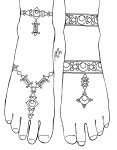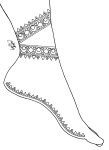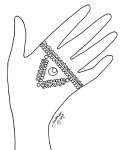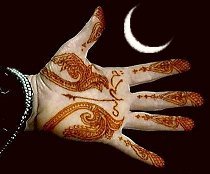|
"Id al-Fitr" copyright Catherine Cartwright-Jones 2003 Kent State University
Ramadan is a month when Muslims pray, fast, go without water, abstain from fleshly and social pleasures, reflect, and concentrate on their spiritual life. This fast is observed for 4 weeks from crescent moon, to crescent moon. This period is similar to the Christian tradition of Lent, preceding Easter. A person may atone for sins by observing the Ramadan fast, as Christians absolve their sins by keeping the Lenten fast. All Muslims who can are required to maintain this fast during daylight hours. Children, pregnant women, sick people, and travelers are not required to fast. At dusk, people may eat and drink again. During this season, in traditional village life, women laid aside their traditional cosmetics such as henna, kohl and perfume as part of their abstinence. At the end of Ramadan, at the sighting of the new crescent moon, Muslims return to the joys of physical life: food, drink, and sexuality, appreciating the gifts of life more for the month's privation. Henna is a symbol of, and part of, the earthly delight in being alive. The end of Ramadan is celebrated with gifts, family parties, street carnivals, new clothing … and henna! This celebration was called “The Little Feast”, or the “Id al-Fitr” comparing it to “The Great Feast” of “Id al-Adha” at the end of Hajj. Village celebrations often went on for 7 days, and this was a favorite time to schedule marriages. In Turkey, Egypt, Morocco, Algeria, Arabia, Iran, Iraq, Pakistan, all the countries across North Africa to South Asia, Muslim people look forward to Id celebrations, as Christians look forward to Easter. To the extent that each family could provide, everyone had new clothing, jewelry, shoes, and gifts. Women scheduled a special trip to the village bath the evening before "Id al-Fitr". They had given up perfumes and cosmetics for Ramadan, and were anxious to clean up to look their best in their new holiday clothing. At the hammam, the village bath, they washed and hennaed their hair, hennaed their fingertips, palms, and soles. If the women had the means and the leisure time, they would arrange for a henna artist to come to their home for a henna party. They celebrated their return to adornment and beauty with their perfumes, their jewelry, their kohl, and their henna. In most ethnic groups, Muslim women traditionally removed all their body hair, and then hennaed their bikini zone to soothe the rash! Because this was a busy holiday season, and henna takes time to apply and dry, most women got simple patterns, less elaborate than a bridal pattern. Well-to-do women could afford the time and expense of a professional artist to have prettier patterns. Most people applied henna at the end of Ramadan. Children, older women, and men would have just a little henna, perhaps just their soles, or fingernails. Doting people would henna their pet dog, staining the tail and paws. Light colored dogs might also have their ears hennaed, a mark on their foreheads, or a hennaed patch on the back or flank. Favorite horses had their tails, hooves and legs hennaed, though this indulgence was only for the wealthy, and sometimes reserved for the ruler. Sometimes even the roof post of the house got a dab of henna. In Bahrain at "Id al-Fitr", itinerant merchants and carnival operators put up little ferris wheels and merry-go-rounds in available vacant spaces. Children often get little gifts of money for the holiday, and they love to spend it at these carnivals. Docile donkeys are scrubbed up, beautified with henna, and put out in fancy harnesses, and children gleefully pay a few coins to have a holiday ride on these hennaed donkeys! Would you like some simple patterns appropriate for Id
al-Fitr?
      New Moon patterns by Ilithiya References: "Ritual and Belief in Morocco, Vols. I and II"
The Omar Family "Fatima and her Sisters"
Return to the Encyclopedia
of Henna Index
|
